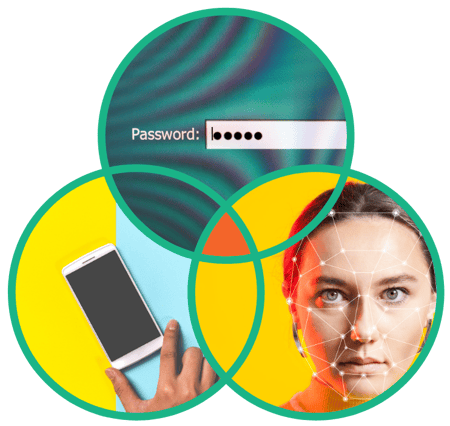How Multi-Factor Authentication with Biometrics Eliminates Fraud
Share this article:
In a world plagued with cyber threats, an added layer of protection and authentication is all that's standing between a business and hackers out for sensitive information.
Chances are that your employees are a significant part of this threat. Research shows that employees are accountable for nearly 50% of all data breaches to date.
This makes it imperative to add a verification process to their access to company networks and devices. And user authentication is perhaps the most effective way to authorize your staff.
The Basics of User Authentication
Authentication is the process of confirming a person or user is who they say they are.. This usually requires a user ID and password combination to identify whoever's trying to log in.
But this method of identification is no longer sufficient.
If a criminal acquires a valid username and password, they gain access automatically. So, in the strictest sense, a username and password don’t verify a user—they only authorize a device using those credentials.
This weakness in password-based user authentication has resulted in companies getting hacked after their login credentials got exposed online. A password – no matter how complex or strong – is not enough.
That's why the race is on to find a more secure form of authentication.
Why Multi-Factor Authentication (MFA)?
Multi-Factor Authentication is part of IDaaS (Identity-as-a-Service). It ensures that personnel only get access to resources, files, and software that they have the requisite permission for.
MFA adds layers of security to your system by asking users for more than one identifier. So, in addition to the correct password and username, they'll be asked about the following:
- Something they know, for example, digital security measures including passcodes and PINs
- Something they are, for example, biometric scans as verification of physical identity
- Something they have, for example, a mobile phone, key fob, or wallet

Multi-Factor Authentication uses at least two of these categories and may also require a biometric identifier. You are not using MFA if you combine two factors from the same category—for instance if you use both a PIN and a passcode to verify identity (they're both parts of something you know). That would still be single-factor authentication.
Let's explore these methods in detail.
Methods of MFA
You can use any combination of factors from the three categories mentioned above to keep your organization's data and accounts secure.
One of the most familiar examples of MFA is ATM cash withdrawal. Users withdraw money through debit cards and have to enter a PIN to access their funds. The card is something the user has, and the PIN is something the user knows.
Some authentication techniques are best suited for certain channels. For instance, a financial organization will use a different authentication technique than that used by a governmental agency. Find the best fit for your business's verification needs.
Something You Know
This category includes the following knowledge factors:
Passwords
Passwords are easy to set up and are still the primary authentication technique used by businesses globally. But passwords are frustrating for users because password complexity requirements make them harder to remember, creating friction within the user experience (UX).
Google's 2019 online security survey highlighted that 52% of people used the same password across multiple accounts. This is especially concerning since it's easy to break or steal passwords through brute force, third-party interception, and spying.
PINs
Personal Identification Numbers are a 4-digit numeric code used alongside cards (from the "something you have" category). This combination makes PINs a lot safer than stand-alone passwords.
Plus, fraudsters have only a few attempts to guess a PIN. Otherwise, the security framework uses its lock-out feature to block them. So, don't allow users to use a PIN that's easy to discover, such as a birth date.
Identifiable Picture
Your security system provides a picture to the user when registering their account. They have to remember it for future login attempts, as the system will show them several options and ask them to choose one assigned to them earlier. While this is a complex technique to implement, users are likelier to remember pictures than passwords.
Security Questions
These questions are factual and ask for information that only the user should know. This usually includes questions about their mother's maiden name or their first pet's name. While it's easy to remember answers to these questions, imposters can find these facts through social media.
Something You Have
This category isn't ever used on its own since anything you possess can be easily duplicated or stolen. This category is often combined with a factor from the "something you know" category. This combination is the most common MFA method in use and includes the following:
Cards
Some security organizations issue electronic identity cards to employees. However, these can be stolen, so it's best to use them in combination with a PIN (or a biometric identifier).
USB Token
Users plug their USB tokens into the computer's port to access permission-restricted information and applications. USB tokens are usually used alongside passwords—a combination of "something you have" and "something you know."
Mobile Phones
These fall into the “something you have” category and support a variety of authentication techniques from the "something you know" category. Smartphone users have their devices on them all the time, making this the preferred approach to verification.
Three kinds of authentication techniques are applicable here:
- The system sends an SMS to the employee's phone that contains a unique One Time Password (OTP), which they enter to gain access
- The system generates an automated call that the employee must answer to gain access
- The system works in tandem with a soft token application installed on employees' phones to generate time-based OTPs for users attempting to access the system
Soft token generation is an increasingly popular authentication method since it enables users to sidestep privacy concerns about providing their phone numbers to the system.
Something You Are
This category uses inheritance factors, called biometrics, to determine whether individuals really are who they say they are. The majority of smartphones today have fingerprint sensors and high-quality cameras, making these authentication methods easy to implement.
You should use biometrics in combination with other authentication methods. While there is no way to hide inheritance factors, several usability issues can lead to false positives. That's why biometric authentication systems also require a bypass mechanism in the event of false negatives. The bypass system can be a passcode or another biometric verifier.
The two main categories of biometric authentication are physical characteristics and behavioral metrics. Physical identifiers include fingerprints, retinas, and facial patterns, while behavioral metrics include keystroke rhythm and voice intonation.
Biometric authentication uses the following:
- Facial Recognition
- Fingerprints
- Iris Scans
- Vein Pattern
- Keystroke Rhythm
- Speech Patterns
Over 75% of US consumers have used or are using some type of biometric technology. Apple popularized FaceID through their iPhone X, and many other companies are following suit in normalizing biometric authentication.
Why Using Multi-Factor Authentication with Biometrics is Essential
92% of businesses believe that the future of security is passwordless. Are you one of them?
If you want to reduce the risk of phishing and replay attacks, passwordless MFA solutions are your best bet. Organizations must use this increasingly essential security feature across all critical access-controlled accounts.
But MFA usually only requires "something you know" and "something you are" to authenticate access. It doesn't cover “something you are” or biometrics to verify if it's the right person at the other end.
Use biometric security solutions to augment your MFA's effectiveness, because hackers have no way of spoofing the unique personal characteristics of an individual. These inheritance factors cannot be forgotten, lost, shared, or spoofed. Biometric verification provides company data and employees a much higher level of security. Using biometrics as part of your MFA allows your business to become passwordless, eliminating the many security problems that come with passwords.
The beauty of biometric authentication is that it can go mobile, giving organizations the ability to verify users who work remotely. The majority of smartphones today have fingerprint sensors and high-quality cameras that make facial recognition easy. All that’s required is to install an app and enable face and fingerprint recognition to implement these measures.
Are You Prepared to Go Passwordless?
Biometrics reduces the chances of fraud and unethical activity on your network by making it impossible for criminals to impersonate an employee. This is the most secure method to create a frictionless UX and ensure your business infrastructure's security.
IDmission combines biometric and knowledge verifiers to produce an end-to-end authentication solution that makes for a truly comprehensive MFA system.
Get in touch with IDmission today and find out how to eliminate identity theft and fraud while enhancing UX. Or download the Say Goodbye to Identity Theft Solutions Guide today to find out how to keep your company and client data safe while enhancing the UX.


Leave a Comment